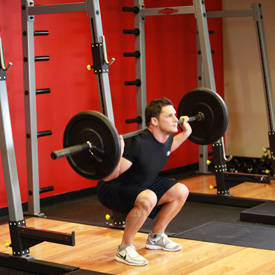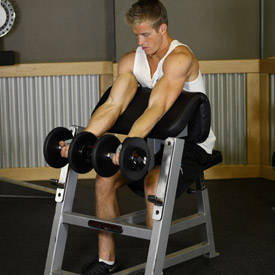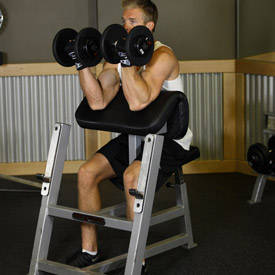Most novices who resistance train think of a contraction as the pushing movement on a bench press or bringing the bar to your chest on lat-pulldown, but in actuality, those movements are only half of a "complete" contraction. The movements just mentioned are commonly referred to as the "working part" of the repetition and are called concentric or positive contractions.
Whereas the other portion of a repetition such as lowering the bar to your chest on a bench press or letting the cable raise on a lat-pulldown is called the eccentric or negative contraction. In essence, during a positive contraction, your muscle fibers shorten. During a negative contraction, your muscle fibers lengthen.
So even though you may feel like it's effortless to lower the bar to your chest on a bench press, your muscles are still working and contracting, except just eccentrically/negatively. Your muscles contract eccentrically in order to control the weight to its natural position safely (e.g. your chest on bench press).
Why Do Muscles Get Bigger & Stronger?
Now that you know what a negative contraction is, let's discuss why resistance training makes you bigger and stronger if you already don't know. The point of resistance training is to cause skeletal muscle damage. Or what I like to call "positive damage".
When you work out you cause microscopic tears in the muscle fibers and with adequate rest and nutrition, the fibers repair and regenerate and are able to handle future bouts of similar work while experiencing significantly less damage. What does this mean to you?
It means you cause positive muscle tissue damage, your muscles repair, adapt to the demands you place on them and you become bigger and stronger. By progressively forcing your muscles to do more and more work over time, this repairing process will repeat and your muscles will continue to grow and get stronger.
Bringing It All Together
Now to my main point - using negative training to build stronger and bigger muscles. Without beating around the bush any longer, eccentric contractions cause greater muscle damage and thus provide the stimulus to make your muscles grow and strengthen. This may be due to eccentric contractions allowing greater force production in addition to less fiber recruitment, which means the fibers are stressed more and more damage occurs.


Barbell Squat
This damage usually is experienced by the soreness you feel the next day or two. If you've ever experienced the soreness in your thighs while performing simple tasks such as walking down stairs or sitting on the toilette days after a tough leg workout, you know what I mean.
If it wasn't for eccentric contractions you'd fall on your ass during a squat, slam the weight stack back down on leg extensions and leg curls, and probably cave your chest in with the force from your knees on a leg press machine.
Working Negatives Into Your Routine
One way to work negatives into your program if you have a training partner is to do eccentric-only contractions for one exercise. This will allow you to really increase the weight you normally use, because you can create greater force production eccentrically. One of the best examples is with the leg extension machine. Load up the plates or set the pin in the weight stack with much more than you normally use.
Have your training partner(s) lift the leg pad up all the way for you and then you fight against the resistance on the way down and slowly lower it, then your partner(s) will lift it up again and then you will perform the negative again. Repeat for 6-10 reps total for no more than 3 sets for one exercise per session. The National Strength and Conditioning Association suggest using a weight of 125% of your 1RM for the exercise.
So if your maximum weight for one concentric repetition on the leg extension is 100 lbs., then you would set it to 125 lbs. and perform as many eccentric-only repetitions as you can.
You may also want to consider performing "forced negatives" sometimes. You will perform a standard set of repetitions and then when you are fatigued and cannot perform one more concentric repetition a partner will lift it for you and then you will work the negative by yourself. Repeat for 2 to 4 reps or until fatigued.


Two-Arm Dumbbell Preacher Curl
I would only recommend that you perform this kind of training at the end of your last set for each muscle group to completely fatigue the targeted muscle. Keep in mind that this kind of training can be implemented without a workout partner for exercises that you can use dumbbells with one arm at a time for. You would simply spot (perform the concentric portion of the movement) with your free hand.
It works well for arm exercises such as the preacher dumbbell curl and any of the variety of dumbbell triceps extensions. In my opinion, one muscle group in particular that I feel responds well to added emphasis on negatives and slow and controlled repetitions are the abdominals - All you need to do is slowly return to the beginning position while keeping constant tension in the abdominals before contracting concentrically again.
Conclusion
Don't go overboard with negative or eccentric training, because it will cause more skeletal muscle damage than normal and will require more recuperation and recovery time. Performing negatives too much may then cause you to become overtrained. Also keep in mind that if negatives are not performed properly and safely you risk unfavorable damage to your connective tissues as well as your muscles by stretching them too much.
This can be avoided by not performing negatives every training session, or at the very least by changing the kind of negative training you used last. By safely incorporating eccentric training into your current resistance training program you will create greater overload and spark new growth and greater gains.
References
- Baechle, T.R., Earle, R. (2000). Essentials of strength training and conditioning - 2nd edition. National Strength and Conditioning Association. Human Kinetics.
